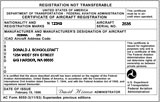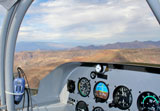|
Experimental Light Sport Aircraft Airworthiness CertificationsGeneral InformationExperimental Light Sport Aircraft (LSA) airworthiness certificates are categorized within six classes of aircraft: airplanes, gliders, powered parachutes, weight-shift-control aircraft (commonly called trikes), gyroplanes, and lighter-than-air aircraft (balloons and airships). ELIGIBILITY Three types of LSA are eligible for an experimental light sport airworthiness certificate. 1. Ultralight-like vehicles that do not meet the requirements of FAR 103.1, including gyroplanes, that are currently operating and have not been issued a U.S. or foreign airworthiness certificate but received an LSA experimental certificate before January 1, 2008, and Ultralight-like vehicles that previously obtained an operating exemption before January 1, 2008. 2. Light-sport kit aircraft or kit-built LSA eligible in accordance with FAR 21.191(i)(2) for an experimental LSA airworthiness certificate. A kit-built LSA must meet the following criteria: - The aircraft is manufactured to the requirements of the applicable consensus standard, and manufactured by an LSA kit manufacturer that has been previously issued a special airworthiness certificate in the LSA category for an aircraft of the same make and model. - The manufacturer’s statement of compliance meets FAR 21.190(c), and the manufacturer identifies assembly instructions for the aircraft that meet the applicable consensus standard. - The applicant is able to provide the aircraft documentation required by FAR 21.193(e). - For an aircraft kit manufactured outside the United States or an aircraft assembled outside the United States from a kit, evidence that the aircraft kit was manufactured and/or assembled in a country with which the United States has a bi-lateral airworthiness agreement and is eligible for an airworthiness certificate, flight authorization, or other similar certification in its country of manufacture. 3. Aircraft previously issued an LSA category airworthiness certificate under FAR 21.190 are eligible for an experimental LSA airworthiness certificate. GENERAL DESIGN AND CONSTRUCTION An LSA manufacturer’s kit may be eligible for an experimental light sport certificate for the purpose of operating an LSA as defined in item 2 above, provided the aircraft is constructed in accordance with the criteria set forth in the applicable consensus standard. The aircraft must be assembled in accordance with the manufacturer’s assembly instructions included in the applicable consensus standard. Before certification, alterations to the kit components or deviations from the assembly process must be coordinated with and approved by the LSA kit manufacturer and documented in the aircraft records. Aircraft previously issued a special airworthiness certificate in the light-sport category may be eligible for an experimental certificate for the purpose of operating as a LSA. These aircraft have previously been flight tested and are not required to have additional flight testing unless they have been altered. All alterations must be recorded in the aircraft records before the original certification. For a major change to the aircraft, the FAA may modify the experimental LSA operating limitations with special restrictions for flight testing due to the aircraft modification. KIT ASSEMBLY 1. Aircraft that are eligible for an experimental light sport certificate must be designed in accordance with the applicable consensus standard, and assembled in accordance with the LSA kit manufacturer’s assembly instructions. The detailed design data, quality systems, and procedures will not necessarily be the same as that of the holder of a type design and production certificate (PC) for the production of aircraft. The components of LSA kit aircraft are not necessarily held to the requirements of type-certificated or supplement type-certificated aircraft, or those of parts manufacturer approval status. 2. The LSA kit does not have to meet a major portion requirement. However, the applicant must show evidence that the LSA is properly assembled in accordance with the manufacturer’s assembly instructions for that aircraft. NOTES The FAA does not certify LSA manufacturer’s kits or approve the kit manufacturers. The FAA does not perform evaluations of LSA kits or LSA kit manufacturers, and no FAA listing of approved or evaluated LSA kits or manufacturers will be provided. The FAA inspection of an LSA will be limited to a general airworthiness inspection when the aircraft is submitted for experimental light sport airworthiness certification. The FAA will not perform any progressive inspections during the construction or assembly of the aircraft. When the LSA kit builder contacts the appropriate FAA office to advise the FAA of the project, the FAA will provide the kit builder with the applicable forms and any guidance necessary to ensure a thorough understanding of applicable regulations. When an applicant is seeking to obtain an experimental light sport certificate and intends to use the aircraft for flight instruction for compensation or hire, please note that this provision will expire January 31, 2010, in accordance with FAR 91.319. After expiration, the aircraft cannot be operated and the applicant must apply for a recurrent airworthiness certificate and amended operating limitations. An applicant seeking to obtain an experimental light sport certificate for a kit-built aircraft should note that the aircraft will have to be in compliance with FAR 91.319(b). To show this compliance, the aircraft must be test flight flown in accordance with the applicable consensus standard acceptance flight test. Please note that the aircraft must not be modified or altered without manufacturer’s approval before initial certification. The FAA office will furnish an applicant for an experimental light sport certificate with the following forms: - Aircraft Registration Application, Form 8050-1;- Application for Airworthiness Certificate, Form 8130-6, dated October 2004 or later; and- Affidavit of Ownership, Form 8050-88A. At the time of airworthiness certification: - The aircraft should be complete in every respect, and - The applicant must submit all required documentation. Such documentation includes appropriate completed FAA forms, the aircraft’s documentation in accordance with FAR's 21.191 and 21.193, and, when applicable, the aircraft maintenance records in accordance with FAR 43. WEIGHT AND BALANCE Before certification, the applicant should accurately weigh the aircraft to determine the aircraft’s empty, gross, and most forward and aft CG location prior to the initial flight tests to help reduce stall, spin, and other control-related accidents. If the aircraft is constructed from a kit, the predetermined manufacturer’s data should be used. The completed weight and balance report should be available on the aircraft along with the other applicable placards, listings, and markings required by FAR 91.9. Before issuing an experimental light sport certificate, the FAA will verify that the weight and balance data is accurate for that aircraft, the aircraft has been weighed correctly, and the CG and its most forward and aft CG limits are established. TRANSFER OF AIRWORTHINESS CERTIFICATES An airworthiness certificate is transferred with the aircraft if there is a change of ownership or transfer of registration. There is no FAA inspection required after transfer of an aircraft with its airworthiness certificate unless it is determined that revised operating limitations are necessary. In this case, a new Form 8130-7 must be issued to reflect the new date of the revised operating limitations. In some cases, an LSA may be sold with an expired airworthiness certificate. In this case, a new Application for Airworthiness, Form 8130-6, is required before an airworthiness certificate can be issued along with operating limitations. To obtain a repairman certificate for that aircraft, the applicant must meet the requirements of FAR 65.107. PROTOTYPE AIRCRAFT PRODUCED BY A LIGHT SPORT KIT MANUFACTURER When a light-sport prototype aircraft is flown by the manufacturer under an experimental light sport certificate to ensure there are no adverse flight characteristics and the manufacturer provides the necessary documentation with the appropriate FAA forms and applications, the aircraft is then eligible for transfer to LSA category certification. An application for airworthiness certificate in the light-sport category or experimental light-sport aircraft purpose cannot be accepted for a manufacturer’s prototype aircraft. The FAA may issue an experimental certificate for the purpose of R&D as long as the applicant’s flight test program is in accordance with the applicable consensus standard. Following termination of an R&D program, such prototype aircraft may be eligible for an LSA category certificate, or an experimental purpose with appropriate operating limitations issued for that purpose. LSA manufacturers also may be eligible to receive an experimental certificate for the purpose of conducting market surveys, sales demonstrations, and customer crew training. The airworthiness certificate may be issued only after the applicant has satisfied the requirements of FAR 21.195(d). Click on the following links for specific information related to those topics: |









